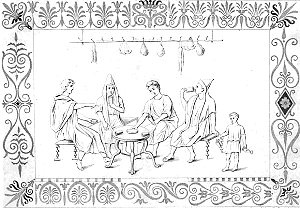Plate LXXX - Drinking scene

Back to chapter 12 |
This scene, Plate LXXX, which is found, in
exceedingly bad company, in an inner room of the
lupanare, is, though superior in style to the
profanations of the art by which it is surrounded, but
moderate in execution. The picture itself is
nevertheless valuable, being the only one yet
discovered in which a common table, with a party
sitting round it, is represented. On the left, a figure
in a dress of dark green seems of superior rank to the
rest of the company, whose hoods are like those of the
capotes of the modern Italian sailors and
fishermen. |
Horns were used for cups in very ancient times, as may be learned from several of the Greek scholiasts. Bacchus was called Corniger from this circumstance, according to the scholiast on Nicander. The Sileni were the nurses of the horned Bacchus. Horns, says the scholiast on Homer, Iliad, Q. v.189. were used previously to the invention of cups. Nonnus says, «He held in his left hand a horn filled with delicious wine».
Λαιὴ κέρας μὲν εἶχε βεϐρισμένον ἡδέος οἴνου
It would appear that the ancients, during their feasts and
ceremonies, the representations of which have come down to
our times, studied and practised what was best suited for
show and conducive to elegance, but that their common usages
and everyday customs were not very widely different from
those of the moderns in the same country.
Nearly opposite this house were found, at an elevation of
more than twelve feet above the pavement of the street, eight
or ten skeletons, with a gold chain, four gold coins, two
gold rings, twenty-six silver medals, a candelabra, and other
utensils in brass and earthenware. These persons must have
been smothered by the vapour while searching for objects of
value among the ruins already half buried.
The learned Dr. Panofka, of Berlin, who visited Pompeii in
the month of April, 1829, saw another chamber of the lupanare
excavated, and reports that the paintings are of a much
higher order, both in subject and execution. On one side is a
female with a lyre, and opposite is Anchises with a boy,
supposed to be Aeneas. A third wall has Ulysses and Penelope,
like that in the Pantheon ; and the fourth has Paris and
Helen. Paris is sitting in the posture of the Paris of M.
Hawkins's beautiful bronze, and Hector is near, chiding him
for not returning to the battle : a beautiful Homeric
subject, which would be a great ornament to this work.
In the border are given ten different specimens of ornamental
borders from Pompeii.